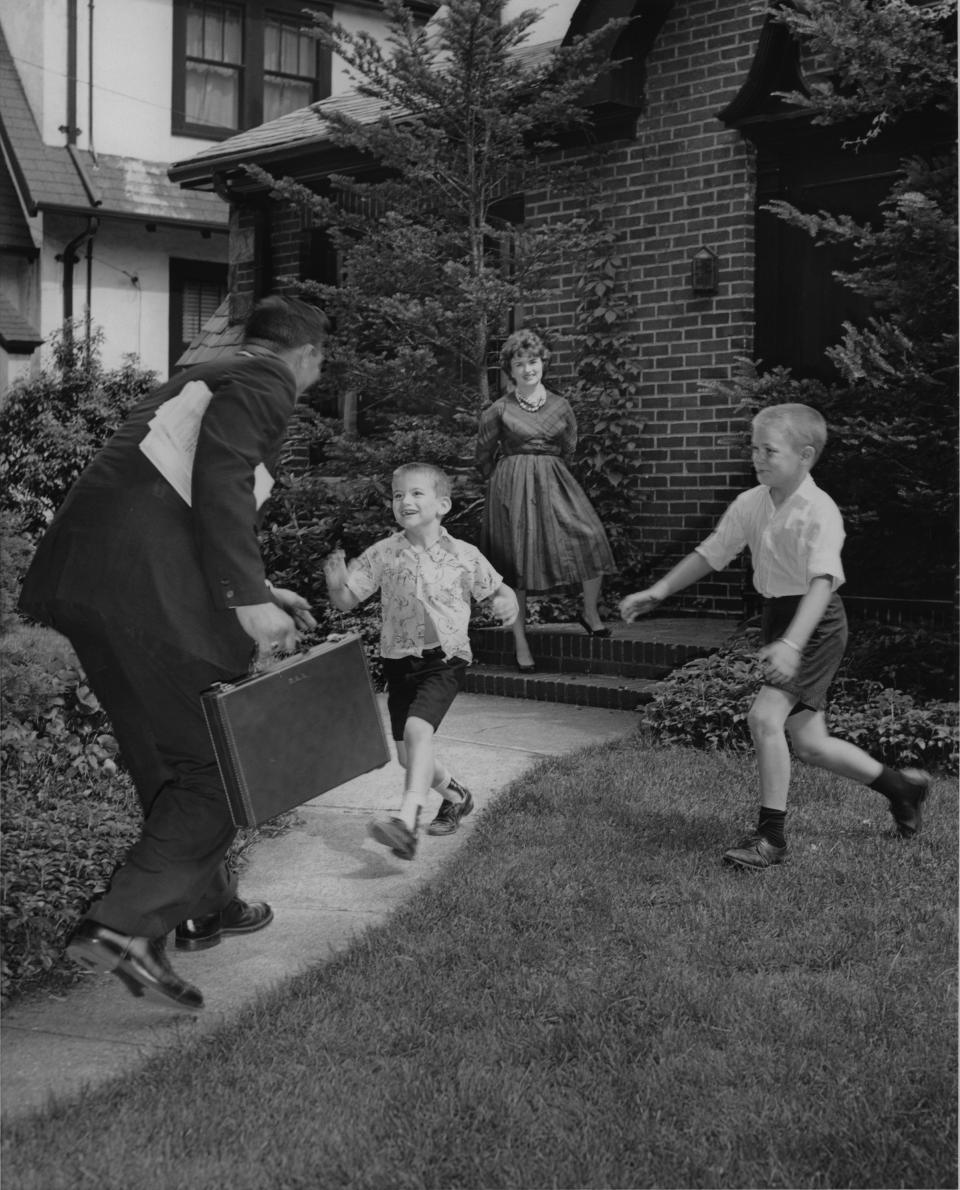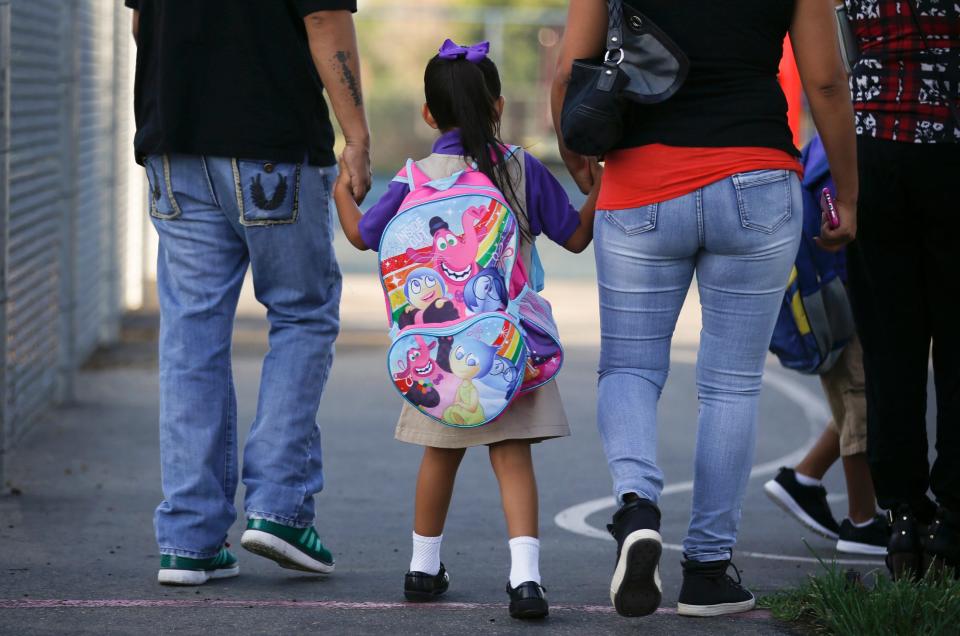Farewell — and good riddance — to the 'typical American family'
For most of the 20th century, the word "family" in America evoked a predictable picture of cookie-cutter cleanliness: the happily married husband and wife, their 2.5 kids, and one improbably well-behaved golden retriever, all under the same roof. But the nuclear family has steadily eroded over the last 50 years.
The first major death knell came with the 1973 oil crisis and the two-year recession that followed, which signaled the end of the West's postwar prosperity boom. Since then, the nuclear family has crumbled piece by piece. In 1970, more than two-thirds of American adults between 25 and 49 lived with a spouse and at least one kid. By 2021, only 37% of adults fit the bill, Pew Research found.
Although it may be premature to declare the nuclear family officially over, the model is beginning to look more like a fringe lifestyle choice than the bedrock of American society.
The demise has sparked no shortage of (often racist, sexist, and homophobic) political backlash. From Elon Musk, the father of 11 kids, to the failed GOP presidential hopeful Vivek Ramaswamy, defenders of so-called "traditional family values" decry the potential economic hazards of plummeting birth rates and the social disorder caused by unruly men without wives to rein them in. Some even argue that the nuclear family is the cornerstone of democracy itself.

Others, meanwhile, have eagerly cheered on the shift away from the stifling gender politics of the four-person norm. Critics include radical family-abolition scholars such as M.E. O'Brien, whose 2023 book "Family Abolition: Capitalism and the Communizing of Care" argues that the contained family structures "cannot carry the immense burden of work placed on them." On the other end of the political spectrum, in an early 2020 cover story for The Atlantic, the conservative columnist David Brooks declared the nuclear family "a mistake." Since the onset of the pandemic, the looming cloud of skepticism hanging over the whole concept of the "nuclear family" has only thickened.
Like it or hate it, the future of the family has never appeared so uncertain. For a society structured around the ideal of the nuclear family, its demise has left everyone wondering: What happens now?
Like many other social norms, the nuclear family was the product of the economic and cultural conditions of a particular time and place, upheld by policies and institutions for decades. Until the 19th century, marriage was less the union of two souls in love than the pragmatic, obligatory step in a long tradition of social and family organization. Most Americans at that time lived in extended, multigenerational "corporate families" that worked together to run a family farm or a business.
As the economy industrialized over the course of the 19th century, more young men and women left their family farms for jobs in factories and offices, usually in cities. Free from the watchful eyes of their parents and relatives, these young people began to go on dates, spending their discretionary income on outings to the local movie house or soda counter. In her 2016 book "Labor of Love: The Invention of Dating," Moira Weigel traced this shift. "By bringing courtship out of the home and into the marketplace, dating became a lucrative business," she wrote. "For the first time in human history, dating made it necessary to buy things in order to get face time with a prospective partner."
As dating culture became more entrenched in the economy during the 20th century, a community-based way of life gave way to individuals focusing on their own wants and needs. The middle class expanded and children were no longer expected to work for their family's economic survival; in white, middle-class families, men earned the wages that supported the family and their wives raised the children and ran the home. The nuclear family became a microcosm of capitalist self-sufficiency and the consumerism that came with it.
It was also, in some respects, a fluke. As Brooks noted in The Atlantic, the nuclear family's status as the default household arrangement for American adults peaked during the relatively brief window between 1950 and 1965, when divorce rates plunged, fertility rates boomed, and the postwar economy flourished. It was during these years that "a kind of cult formed around this type of family," Brooks wrote, noting that those who broke the mold by opting out of marriage were often seen as deviant or "neurotic."

The obsession with the nuclear family masked its underlying instability. By the 1970s, social inequality and wage stagnation following the 1973 oil crisis and recession had made it impossible for many white, middle-income husbands to sustain entire broods on a single salary. More and more women entered the workforce, giving them greater economic autonomy and enabling some to leave unhappy marriages. After California legalized no-fault divorce in 1969, other states quickly followed. In turn, divorce rates soared. (To this day, women initiate the overwhelming majority of divorces.)
The nuclear family began to rapidly disintegrate. But it wasn't exactly the end of a golden era.
As more people have formed families that diverged from the nuclear-family norm, the weaknesses of the structure have become glaring. The biggest fallout we see today is in the childcare crisis, where the self-reliance inherent to the nuclear-family model resulted in women bearing the burden of raising children. Although an overwhelming majority of women now work outside the home, they continue to shoulder the bulk of unpaid caregiving labor for children and aging relatives. They also end up doing more household chores — laundry, cleaning, and cooking are all primarily done by women.
Without one partner focused on full-time housekeeping, the amount of work required to run a nuclear family isn't really feasible. "All families, without exception, are dependent on extensive outside support — whether that's state welfare programs, paid service people, or extended family members generously helping out," O'Brien, the family-abolition author, told me.
The segmentation of families can also "isolate vulnerable individuals, enabling abuse," Stephanie Coontz, the author of "Marriage, a History," told me. And "some such families consciously foster suspicion of those outside the family circle."
While this arrangement works nicely for the wealthiest "shareholders" in a capitalist economic system, it isn't a particularly enticing deal for most Americans, Kristen Ghodsee, an ethnographer at the University of Pennsylvania and the author of "Everyday Utopia: In Praise of Radical Alternatives to the Traditional Family Home," told me.
"The declining birth rate in industrialized countries reflects the economic reality that children are a bad investment for families, and so many people are deciding not to have them," she said. Adjusting for future inflation, the Brookings Institution estimated that it would cost $310,605 to raise a child born in 2015 through age 17 — about $43,000 more in today's dollars than what it cost in 1960 after adjusting for inflation. In a 2021 Pew survey of child-free adults under 50, 44% said they are unlikely to ever have children. When asked why, most responded that they simply don't want to. Nearly one in five said it was due to the cost.
Ghodsee pointed out that while a smaller global population has its perks (the planet certainly isn't complaining), it poses a serious threat to long-term economic growth. "Shrinking GDPs in the future are a direct result of shrinking populations, and that will challenge the very foundations of American capitalism," she said. "This is one reason why conservatives are so keen to limit women's reproductive freedoms."
It doesn't take much of a mental leap to see why capitalism and the nuclear family make for such cozy bedfellows. Atomized family units produce more market labor and buy greater quantities of stuff than sprawling, communal kin groups that can lean on each other to share resources and manpower. The nuclear family's guise of self-sufficiency only barely conceals its toxic codependence with the market economy. But that dynamic also makes the nuclear family particularly vulnerable to economic pressures.
Over the years, people who departed from the nuclear norm stopped being seen as aberrations and became examples of the varied paths adulthood could take. Today, nearly a quarter of children in the US live in single-parent households, and a rising share of adults live without a spouse or romantic partner, either alone or with roommates. Where LGBTQ+ partnership was once criminalized across the country, same-sex unions are now sanctioned under federal law. As of 2020, even polyamorous families have gained legal protections in the municipality of Somerville, Massachusetts.
Despite the growing diversity of household types, the nuclear family of the 1950s continues to shape the economics and institutions of American life. By and large, policies that inform tax systems, housing, healthcare, and social services are designed to provide the greatest benefit to married couples and their children. When my partner and I file our annual income taxes in the coming weeks, we'll enjoy a sizable tax break thanks to our decision to tie the knot last fall. And as a dependent on his employer-provided health-insurance plan, I'm able to make a living as a freelancer without worrying about healthcare coverage. But that narrow policy focus leaves an increasing numbers of Americans behind.
Though it's unclear what the family of the future will look like, seeds of change are blowing in the breeze. Recent months have seen a deluge of magazine trend pieces, Reddit threads, and newspaper headline portmanteaus speculating about polyamorous families, platonic coparenting, and "mommunes" becoming the next big thing. Even the multigenerational household is quietly coming back into vogue, thanks in large part to ongoing cost-of-living increases and families' caregiving needs.
The pandemic seemed to accelerate a collective sense of urgency to come up with something better. "In order for families to function at all, they need lots and lots and lots of external supports," O'Brien said. "During COVID, as some of those external supports disappeared, that became dramatically and painfully obvious to huge numbers of people."
The lockdowns of the early pandemic also foregrounded the social and relational pitfalls endemic to the nuclear family — "the hot box of being around the same people all the time, the lack of feedback and broader social relationships, and the despair and depression that can go along with this type of social isolation, particularly for mothers of young children," O'Brien said.
Ghodsee agreed that the pandemic invigorated people's desire for collectivism and community. Overwhelmed nuclear families reached out to one another for mutual support and formed "pandemic pods." Communities set up mutual-aid groups to share goods and deliver groceries to elderly and immunocompromised neighbors. In the face of urgent necessity, people began to imagine pathways toward a more expansive definition of family. Suddenly, everyone was talking about how to recreate the "village."

"A lot of people who lived alone and who used to think of having their own place as the ultimate symbol of personal autonomy and success became very lonely," Ghodsee said. "Things like co-living, co-housing, and intentional communities are now making a comeback." Two websites that match single adults for the purpose of platonically co-parenting children reported a 30% to 50% surge in traffic during the COVID lockdown, The Guardian reported.
Not everyone agrees that the grass is greener on the other side of the white picket fence. Coontz, a leading historian of the American family, notes that every family structure comes with its own set of distinct weaknesses, strengths, and possibilities. The extended families of yore guaranteed a measure of built-in support and community that was particularly beneficial for raising children. But the extended-family structure also made it "far easier for the older generation to control the younger ones," Coontz said, and tended to undermine the romantic couple relationships in their midst.
No family model is perfectly resilient, equitable, or sustainable in a vacuum. "It's the larger social context that counts most for how any institution functions, and any decent social system needs to put protections in place to minimize the chance of abuse and give people options when the institution fails or abuses them," Coontz said.
She remains unconvinced that rearranging the family structure will resolve its many ails. She also believes it unlikely that the typical American family will ever stray too far from the basic configuration of a romantic partnership and children. What she hopes for is "a society whose institutions and policies encourage personal security and trust beyond our families and friends — to make our lives better when we are in and when we are out of an intimate romantic relationship." This might include investments in "third places," such as public libraries and parks where community members can freely gather, or more radical overhauls such as the provision of a universal basic income, which could reduce inequality and boost social cohesion.
Rather than changing families to be more like society, this vision of the future imagines a society that's more like a big, supportive family.
Kelli María Korducki is a journalist whose work focuses on work, tech, and culture. She's based in New York City.
Read the original article on Business Insider

 Yahoo News
Yahoo News 
